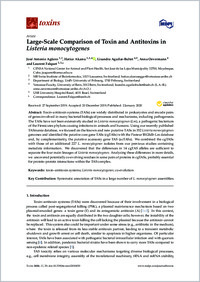Large-scale comparison of toxin and antitoxins in Listeria monocytogenes
- Agüero, José Antonio CENSA National Center for Animal and Plant Health, San José de las Lajas Municipality 32700, Mayabeque, Cuba - SIB Swiss Institute of Bioinformatics, 1015 Lausanne, Switzerland
- Akarsu, Hatice SIB Swiss Institute of Bioinformatics, 1015 Lausanne, Switzerland - Department of Biology, UniFr University of Fribourg, 1700 Fribourg, Switzerland - Vetsuisse Faculty, University of Bern, 3012 Bern, Switzerland
- Aguilar-Bultet, Lisandra Vetsuisse Faculty, University of Bern, 3012 Bern, Switzerland - USB University Hospital Basel, 4031 Basel, Switzerland
- Oevermann, Anna Vetsuisse Faculty, University of Bern, 3012 Bern, Switzerland
- Falquet, Laurent SIB Swiss Institute of Bioinformatics, 1015 Lausanne, Switzerland - Department of Biology, UniFr University of Fribourg, 1700 Fribourg, Switzerland
-
2020
Published in:
- Toxins. - 2020, vol. 12, no. 1, p. 29
English
Toxin–antitoxin systems (TASs) are widely distributed in prokaryotes and encode pairs of genes involved in many bacterial biological processes and mechanisms, including pathogenesis. The TASs have not been extensively studied in Listeria monocytogenes (Lm), a pathogenic bacterium of the Firmicutes phylum causing infections in animals and humans. Using our recently published TASmania database, we focused on the known and new putative TASs in 352 Listeria monocytogenes genomes and identified the putative core gene TASs (cgTASs) with the Pasteur BIGSdb-Lm database and, by complementarity, the putative accessory gene TAS (acTASs). We combined the cgTASs with those of an additional 227 L. monocytogenes isolates from our previous studies containing metadata information. We discovered that the differences in 14 cgTAS alleles are sufficient to separate the four main lineages of Listeria monocytogenes. Analyzing these differences in more details, we uncovered potentially co-evolving residues in some pairs of proteins in cgTASs, probably essential for protein–protein interactions within the TAS complex.
- Faculty
- Faculté des sciences et de médecine
- Department
- Département de Biologie
- Language
-
- English
- Classification
- Biological sciences
- License
- License undefined
- Identifiers
-
- RERO DOC 328397
- DOI 10.3390/toxins12010029
- Persistent URL
- https://folia.unifr.ch/unifr/documents/308676
Statistics
Document views: 98
File downloads:
- fal_lsc.pdf: 187
